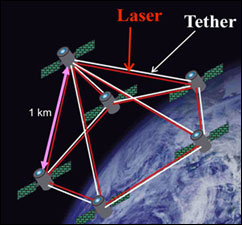TUSTIN, Calif., May 16, 2006 -- A new ultrahigh precision, contamination-free formation flight method based on photon thrusters and tethers may be a solution to maintaining a precise spacecraft (satellite) configuration in space, said NASA.
 The NASA Institute for Advanced Concepts (NIAC) has awarded Young Bae a $75,000 grant to develop the method. Bae is the founder of the Bae Institute, a Tustin, Calif., developer of space and medical technologies. He presented his grant-winning paper at an NIAC Phase I Fellows meeting in March, demonstrating how existing technologies can allow clusters of micro-, nano- and pico-spacecraft to fly in ultrahigh precision formations.
The NASA Institute for Advanced Concepts (NIAC) has awarded Young Bae a $75,000 grant to develop the method. Bae is the founder of the Bae Institute, a Tustin, Calif., developer of space and medical technologies. He presented his grant-winning paper at an NIAC Phase I Fellows meeting in March, demonstrating how existing technologies can allow clusters of micro-, nano- and pico-spacecraft to fly in ultrahigh precision formations.
(niac.usra.edu/files/library/meetings/
fellows/mar06/1047Bae.pdf)
Tethered, or formation-flying, spacecraft have the potential to dramatically lower launch weights and station-keeping costs while enabling a quantum leap in observation resolutions from space, NASA said. Thus far, a solution for maintaining a precise spacecraft configuration in space has proven elusive. The agency said, "Bae's proprietary (patent-pending) photon tether formation-flight (PTFF) system is projected to accomplish this with less-than-nanometer accuracy."
Bae said, "PTFF minimizes spacecraft system architecture, weight and contamination-free power consumption by orders of magnitude over present monolithic space mission systems." His PTFF work has also been published in the peer-reviewed journal of the American Institute of Physics Space Technology and Applications International Forum-STAIF 2006.
The core technology is a combination of a push force from photon thrusters and a pull force from Kevlar tethers for precise intersatellite control. Photon thrusters amplify thrust tens of thousands of times through a proprietary intracavity system for bouncing photons off of mirrors between satellites.
"As a result, the thrust power requirement for formations of 100-kg spacecraft configurations can be reduced to several watts per pair of satellites, well within today's space power budgets," Bae said. "No other propellants are needed, providing mass energy savings and contaminant-free operation for future space missions equipped with highly sensitive sensors."
Bae said his formation-flying control system has NASA and non-NASA applications for precise geophysical monitoring, environmental monitoring, mapping, imaging, surveillance, astronomical or GPS applications.
For more information, visit: www.baeinstitute.com